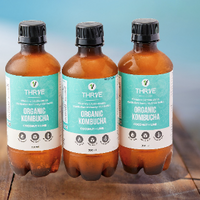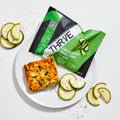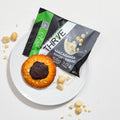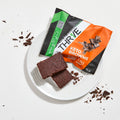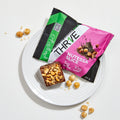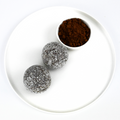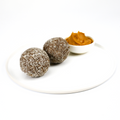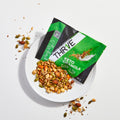Sourdough: its chewy texture and tart flavour has made it an Aussie brunch favourite. But besides the price tag, is it really any different to your regular white loaf? Turns out, sourdough has some surprising health benefits.

Sourdough vs. regular bread
Good nutrition usually comes down to one simple principle: eat real food. Avoid heavily processed ingredients, chemicals and additives when you can. Source good, simple produce that’s cooked with care. Hey presto – you’re on the road to good nutrition.
It’s for this reason that sourdough can play a delicious part in a healthy diet. The style of breadmaking used to make sourdough has been around for thousands of years (yep, even the ancient Egyptians were chomping on the stuff). It most likely started as a happy accident, when wheat and water were left out and fermented, creating a perfect mix of bacteria and yeast. It’s this ‘starter’ that makes the bread rise when baked.
Proper sourdough is still made using flour, filtered water, salt and sourdough ‘starter’. That’s it. The secret here is time: to develop the starter, to mix the starter into flour and water to create leaven, and to leave the dough to rest at various stages throughout the process. This lets the dough thoroughly ferment and really break down the starches and proteins in the wheat.
This fermentation process also means sourdough doesn’t need any preservatives. It’s naturally acidic, so harmful microorganisms can’t survive in its deliciously chewy dough. A study in Applied and Environmental Biology found that unlike regular bread, sourdough can naturally resist mould because the good bacteria convert the linoleic acid in the bread flour to a compound which has anti-fungal activity. Science aside, the sourdough you get at your artisan bakery is basically the OG of the bread world.
Bread only got put in the naughty corner more recently – as the popularity of a new kind of bread grew, too. Over the last century, in a rush to pump out more bread in less time, the natural fermentation process was widely abandoned and commercial yeasts were used instead. Then came the refined white flours, the thickeners and 101 other additives to help emulate the fluffy texture of traditional sourdough.
It’s hardly a coincidence that the rise of this new breadmaking process has been accompanied by a bunch of digestive troubles, too. Sure, gluten is a part of the issue. If you’re coeliac or severely allergic to gluten or wheat, then sourdough isn’t for you. However, gluten might not be solely to blame for more widespread issues with bread. In fact, often people who can’t tolerate a stock-standard loaf find they can eat sourdough.
So why is sourdough superior to many breads?
When traditional bread-making was widely abandoned and chemicals thrown into the mix, the big food companies missed one thing. There is really no chemical that can replicate the effect of time. It is largely time which makes sourdough far easier to digest. “Traditional sourdoughs go through a lengthy preparation and fermentation process,” explains THR1VE Nutritionist Shannon Young. “This longer prep time results in the breakdown of proteins into amino acids, including gluten. The combination of bacteria and yeast in sourdough also helps pre-digest the starches in the grains, which tends to be easier on your digestive system.”
Sourdough also tends to be more nutrient-dense. The combo of good bacteria and wild yeast in sourdough helps reduce something called phytic acid. One of the problems with phytic acid is that it binds to naturally occurring minerals in the wheat, like magnesium and zinc, and stops your body absorbing them. So less phytic acid means more nutrients for you.
Sourdough is often made from less refined wheat flour, which consequently boosts the nutrient content, too. “Your average slice of mass-produced bread normally only maintains a fraction (if any) of the original nutrient content after all the processing it goes through before it reaches the shelf,” Young points out.
It’s for this reason that sourdough can actually be a friend, not foe for your gut. However, this is where the quality of the ingredients make a difference. If your sourdough is made from minimally processed flour that still contains some of the wheat bran and germ, it will give you more prebiotic fibre that your gut thrives on. “A good sourdough’s prebiotic content will feed the beneficial bacteria in your gut and help out the digestive process,” Young says. “These prebiotics can help support immunity, weight management and even brain function.”
Not all sourdoughs are made equal!
With all the discussion of the benefits of sourdough, it’s important to still be wary of the ‘sourdough’ tag. “Many sourdoughs you buy in grocery stores is not genuine and therefore will not give you the health benefits of a ‘real’ sourdough,” Young warns. “Some companies will throw in small amounts of the sourdough starter and other flavours to give the bread the sour taste, but none of the nutritional benefits.”
This is an ingredients list from a popular mass-produced sourdough.

As you can see, there’s commercial yeast, canola oil, emulsifier and more.
The best rule of thumb, regardless of where you get your bread, is just to look for whole and natural ingredients that you recognise. It should be something like freshly-milled sustainable flour, filtered water, sourdough starter and sea salt. Sourdough might not be an every day food or even an every week food for you. The science of gluten intolerance is very much still emerging. But if you can tolerate some gluten, there’s no inherent reason to cut it out altogether. In moderation, it can be a nutritious and delicious part of your diet. Avo smash on sourdough, come at us!


